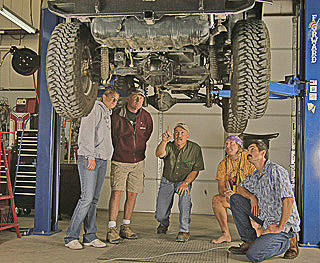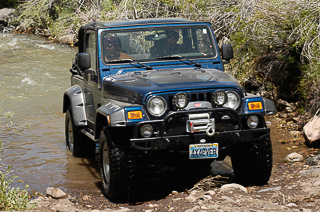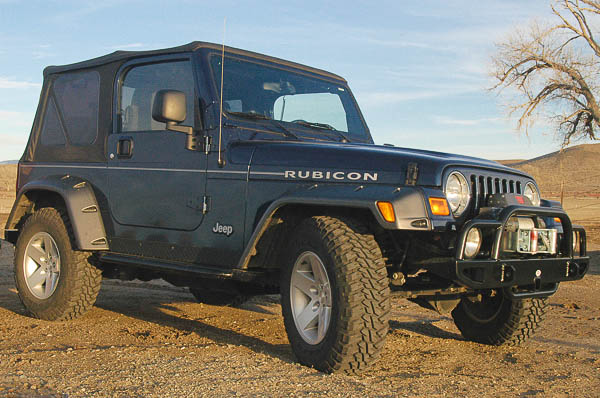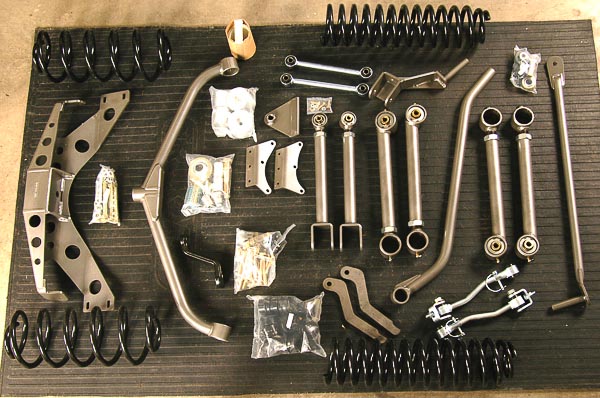
For many Jeep owners, this TJ Wrangler Rubicon edition offers plenty of ground clearance with its factory 31″ diameter tires. Hardcore trail runners prefer even larger tires these days! 33-35-inch diameter is the choice, and in this article, I share my shop and step-by-step photos of what it takes to safely install a quality suspension lift kit!
—Moses Ludel
Most YJ and TJ Wranglers will undergo suspension system modifications. The popularity of oversized tires and wide wheel rim upgrades makes suspension or body lifting a regular practice. While 31” diameter tires are stock on the TJ Rubicon Edition, most models will barely accommodate 30” diameter tires. Many owners find it desirable to “lift” the vehicle and install 33”-35” diameter tires. In some instances, 37” diameter tires find their way onto a modified and lifted TJ Wrangler chassis!
Inherent to any lift is the need to increase the vehicle’s track width to restore center-of-gravity. Wider Mopar Accessories wheels and a variety of aftermarket rim types help meet this need. Decreasing the wheel backspacing and increasing rim width will create a wider vehicle track width. Track width changes are a vital part of safe suspension lifting.
Despite the perceived “simplicity” of a body lift, I prefer a suspension lift rather than raising the body from the frame. There are a several chassis, fuel, brake, cooling and body components that are affected by raising the body above the stock frame position. For even a mild two-inch lift, I will use a suspension lift approach. Suspension kits are available in 2” and taller versions for both the YJ and TJ chassis. As a rule, the switch to 31” tires will require a 2” suspension lift on models other than the Rubicon. The Rubicon models come with 16” x 8” wheels and 31” diameter tires, using a mild factory lift.
33” tires will require a 3”-4” lift over the stock Wrangler suspension. A YJ with leaf springs and a 3.5” lift will accommodate 33” tires. In this article, you will find the step-by-step installation of a TJ Wrangler 4” suspension lift system to accommodate 33” diameter tires.
TJ Wrangler Chassis Design and Suspension Lifts


Moses Ludel and Cody Lundin (Discovery Channel’s “Dual Survival” co-star) co-instruct an off-road survival workshop. Moses explains the TJ Wrangler Rubicon chassis (left) before training this group at safe, environmentally friendly 4WD off-pavement driving. Cody will conduct the aboriginal survival training portion of the course.
TJ Wrangler models maintain the ladder frame and solid beam axle design of traditional Jeep 4×4 trucks. Capitalizing on the success of the XJ Cherokee and the ZJ Grand Cherokee’s link-and-coil suspension technology, Jeep engineers produced a tough Quadra-Coil® suspension system that boasts the added benefits of a ladder frame.
Skeptics challenged the new TJ suspension design in 1997. However, the TJ quickly won over the most ardent rock crawlers. Seven inches more articulation in stock form than the YJ leaf-sprung model, the TJ gained traction, offering unprecedented handling and ride quality in a tough utility 4×4 package. The TJ Wrangler has earned its place in the Jeep truck family, vehicles that date to the WWII MB model.
As soon as the TJ became available, owners contemplated ways to personalize these models. In the tradition of CJ and YJ users, the TJ became an immediate candidate for suspension lift packages to provide room for larger diameter tires and greater ground clearance off-pavement. The aftermarket studied the link-and-coil suspension system in detail, and suspension kits soon followed.
The TJ Wrangler quickly earned status as the most versatile, reliable and advanced trail vehicle in Jeep history. Engineering of the TJ incorporates the best features of each Jeep 4×4 advancement to date yet maintains the integrity of the drivable chassis, iron beam axles and the choice of either a bulletproof, torque twisting seven-main bearing inline six or a feisty four-cylinder engine. If you add the Rubicon Edition’s four-wheel disc brakes, NV241 4:1 low-range transfer case, factory air locking differentials and 31-inch diameter tires, owners hold the keys to the best showroom stock, mass produced 4×4 in the world! This stature survives as the JK Wrangler.
So, what would encourage anyone with a TJ Wrangler, especially a Rubicon Edition, to install an aftermarket suspension system or chassis lift kit? Since the 1960s, owners of trail running Jeep 4WD models have targeted the use of oversized tires for better backcountry access. While many TJ owners strive for these same goals, some simply like the “look” of a lifted Jeep, a vehicle capable of negotiating the most challenging terrain!
Regardless of motive, many owners consider suspension lift packages for their TJ Wranglers. The simplest kits are “short arm” and coil spring changes that provide a mild, 2” or so lift to fit 31” diameter tires on a non-Rubicon model. Short arm variations also provide lifts to four inches, at which point the “long arm” kits also appear. A long-arm kit uses lengthy control arms that attach at non-stock points on the chassis. The added wheel travel and control arm slope angles demand these longer control arms, new drivelines, modified exhaust and other modifications specified by the aftermarket kit manufacturer.
In an effort to meet the needs of both TJ restorers and those interested in suspension improvements, I elected to install an advanced “suspension system” for this 4WD Mechanix© Magazine technical feature. Full-Traction Suspension offers a 4-inch “Ultimate” suspension system in addition to a line of short- and long-arm suspension kits. The Ultimate and Long-Arm kits from Full-Traction Suspension fully revamp the rear suspension layout to provide handling improvements on-highway with dramatically upgraded articulation ability off-pavement.
This Ultimate 4” Suspension System installation provides an opportunity to explore the design and intent of the entire TJ suspension system. Whether you plan to install a suspension lift package or simply rebuild a stock TJ Wrangler chassis, my step-by-step installation of this system draws attention to the unique demands of TJ Wrangler suspension. In addition to the suspension kit installation, you will find details on fine tuning a TJ chassis, including driveline improvements, driveshaft angles, four-wheel alignment and pinion and caster angle concerns. Additional information is available throughout this website.
There is far more to a suspension upgrade than big tires and a certain “look.” A TJ Wrangler must be safe and roadworthy when you finish the installation, as good as new or better. Whether you need to simply upgrade from OE parts or have planned a complete suspension revision, this article provides the necessary details.

This stone-stock 2004 Jeep TJ Wrangler Rubicon is about to gain 3-inches of chassis lift! The Full-Traction Suspension ‘Ultimate’ 4-inch lift and suspension system upgrade will raise a non-Rubicon model four full inches.

Who would believe that a “Rubicon Edition” is not enough? In my view, the showroom stock Rubicon TJ is among the best ‘turn key,’ mass-produced 4×4 models in the world. The owner, in this instance, wants 33” diameter tires and more ground clearance than the stock Rubicon offers. Virtually new when I installed the suspension package, this Jeep provides an optimal vantage for the step-by-step disassembly and reassembly of a TJ Wrangler suspension system. I begin the project with the stock TJ on my hoist and its four-link, Quadra-Coil suspension at full drop.

This is the Full-Traction Suspension 4” ‘Ultimate’ suspension system. Not just a “lift kit,” the package incorporates a short-arm front suspension buildup plus a sophisticated revamp of the rear suspension to an advanced, three-link suspension geometry. This package aims at matching long-arm off-pavement performance while tackling the on-highway “yaw” associated with OE four-link rear suspension systems.
Caution: My step-by-step installation of the Full-Traction Suspension TJ Wrangler ‘Ultimate’ lift kit reflects the kit’s instructions and my many years of exposure to chassis work. When ordering and installing any lift kit or suspension kit, follow the manufacturer’s instructions carefully. Suspension and steering modifications present a variety of safety concerns. Perform the work carefully. If you are unclear how to perform this work, consult with a professional installer or a frame/alignment shop.
See ‘Part 1,’ ‘Part 2’ and ‘Part 3’ for Moses Ludel’s ‘Step-by-Step’ Installation of the FTS ‘Ultimate’ Jeep TJ Wrangler Suspension Lift System!
Copyright 2010-2011 © Moses Ludel…Enjoy this comprehensive, color-illustrated article and photography by Moses Ludel. The article is available solely at the 4WD Mechanix Magazine website and can be viewed here as often as you like. If you wish to share the article with friends or professional colleagues, please refer them to 4WD Mechanix Magazine website: www.4WDmechanix.com. As copyrighted material, this article and the photography cannot be copied or distributed in any other form.—Moses Ludel
